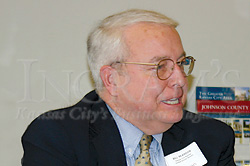
Bill Reardon of Kansas City, Kan. Unified School District says the Kansas Supreme Court hinted at its expectations for funding in its Jan. 3 ruling.
But Mark Desetti of the Kansas National Education Association pointed out that the Kansas public educational system has proven itself quite cost-effective. Despite flat funding from the state for the past several years, he said, Kansas public education has “narrowed the achievement gap significantly…without flattening out the achievement of our highest achieving students. Is that an indication of efficiency? I think it is.”
Inside The Numbers
Bob Corkins, of the Freestate Center for Liberty Studies, challenged the idea that funding for Kansas public education has been flat over the past few years. His information showed that spending has increased twice as fast as inflation over the past ten years.
Alan Cobb of Americans for Prosperity agreed. “It strains credulity a little bit when you’re at $10,000 per student in total funding.”
Trigg dissented vigorously. “Those kinds of numbers include bond and interest payments, capital outlays for buildings, food service funds,” he contended. “I’m concerned about operation funds. How much money do I have to educate a child in a classroom?”
Trigg pointed out that he has two funds from which to draw, a general fund and a local options budget. But, he maintained, not all of those dollars can legally be applied to the education in the classroom. As such, the actual funds per pupil in the Blue Valley school district are closer to $6,300 per student. “That’s not enough, in terms of operational dollars, going to educate kids,” he added.
“Let’s not pretend anything beyond operating expense and the real total is paid for with manna from heaven,” Corkins fired back. “This all comes from taxpayers, it’s all part of the price per student and I think it’s a tremendous disservice to the public to tell them the real cost is anything less than what they’re actually paying for.”
Trigg was not about to roll over. “We have moved from a mandate of universal access to universal proficiency,” he countered, moving deeper into the issue. “It’s a whole different ballgame today than it was ten years ago.” As Trigg explained, ten years ago it was enough to provide access to an education. Today, the demand is for proficiency. “We have a tremendous responsibility,” he added, “and whether we like it or not, it takes money to do that.”
Tallman made the point that total funding for education has gone up every year, but for the most part, the increases have come not from the state but through local option budgets, local sales taxes and federal funding.
Blake West is a math and computer science teacher in the Blue Valley School District currently on leave to serve as a vice president for the Kansas National Education Association. He pointed out that schools are being asked to fund and administer programs—such as full-day kindergarten, before and after school care and extending learning opportunities—all without state funding.
“These are the kinds of programs that stand on the outside of what we are able to afford in the current system and they’re the kinds of things that are absolutely essential if we’re going to close the achievement gap,” said West. “It’s not just an inner city problem or it’s not just a problem of an English-as-a-second-language student—it’s a problem that we have to face in all districts across the entire state.”
Tallman concurred, stressing “we’re in an environment where our elected officials at the federal level and the state level are telling us we have to do more. We have to do better. The state board of education increased graduation requirements. No Child Left Behind is essentially saying too many kids are being left behind. So we are giving public education a significantly bigger job.”
Sutherland dissented. “We’re supposed to throw money at the problem and then define what’s a suitable education?” he asked Sutherland. “We need to define a suitable education, and then figure out what we need to do to fund it.”
A Suitable Education
On the issue of a suitable education, Desetti declared that Kansas is moving from a purely agricultural and manufacturing state to one trying to compete in an information-based society, “It’s no longer enough—and I don’t think it ever has been—to say ‘this is good enough. If we give (students) the opportunity to read, that’s suitable.’ That’s just not going to cut it for this century and the future of our state.”
“That sets an impossible standard,” countered Sutherland. “Until we define what a suitable education is, we can only guess. The Legislature can’t act unless they get some guidance from the courts.”
But the courts, not the Legislature, are the crisis, said Corkins, claiming that many of the issues raised by the Kansas Supreme Court are in fact statutory rather than constitutional.
Still West pushed back, saying, “There is no crisis because a court has said so; there is a crisis because the flat or zero increases (from the Kansas Legislature) have made it more and more difficult to move in the direction of 21st century skills.”
Corkins stood firm, saying, “The constitution does not require a suitable education. Suitable education is a statutory objective. It is not a constitutional mandate.” Corkins pointed out that Kansas constitution says only the legislature will provide “suitable provision for finance.”
Next»